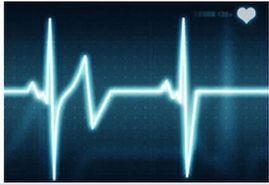Pulse Rate: Difference between revisions
(addeedvrefernces) |
No edit summary |
||
| Line 13: | Line 13: | ||
Peripheral pulses: pulses that can be felt at the periphery of the body by palpating an artery over a bony prominence. Examples are Carotid, Radial and Popliteal pulses | Peripheral pulses: pulses that can be felt at the periphery of the body by palpating an artery over a bony prominence. Examples are Carotid, Radial and Popliteal pulses | ||
Apical pulses: It is a central pulse located on the apex of the heart that is monitored using a stethoscope.<ref>Susan B, Thomas J, George D. Physical Rehabilitation sixth edition. USA: F.A. Davis 2014.</ref> | Apical pulses: It is a central pulse located on the apex of the heart that is monitored using a stethoscope.<ref name=":0">Susan B, Thomas J, George D. Physical Rehabilitation sixth edition. USA: F.A. Davis 2014.</ref> | ||
== parameters of Pulses == | == parameters of Pulses == | ||
Rate: It is the number of pulsation which could be bradycardia (less than 60 beats per minute) or Tachycardia( more than 100 beat per minute) | Rate: It is the number of pulsation which could be bradycardia (less than 60 beats per minute) or Tachycardia( more than 100 beat per minute) | ||
Rhythm: it is the time interval between pulse beat | Rhythm: it is the time interval between pulse beat<ref name=":0" /> | ||
== Factors that Influence Heart Rate == | == Factors that Influence Heart Rate == | ||
| Line 25: | Line 25: | ||
*Emotions/Stress | *Emotions/Stress | ||
*Exercise | *Exercise | ||
*Medications | *Medications<ref name=":0" /> | ||
== Pulse site == | == Pulse site == | ||
| Line 40: | Line 40: | ||
Popliteal | Popliteal | ||
Dorsalis pedis | Dorsalis pedis<ref name=":0" /> | ||
== Indications of elevated pulse(tachycardia) == | == Indications of elevated pulse(tachycardia) == | ||
| Line 48: | Line 48: | ||
# Electrolyte imbalance | # Electrolyte imbalance | ||
# Alcohol | # Alcohol | ||
# Emotional stress | # Emotional stress<ref>Medtronic. available from: www.medtronic,com/au-en/your-heart/conditions/fast-heartbeat.html</ref> | ||
== Indication for reduced pulse rate(bradycardia) == | == Indication for reduced pulse rate(bradycardia) == | ||
| Line 59: | Line 59: | ||
4.Medications | 4.Medications | ||
5. Inflammatory diseases such as rheumatic fever | 5. Inflammatory diseases such as rheumatic fever<ref>Mayoclinic. available from: www.mayoclinic.org/diseases-conditions/bradycardia/symptoms-causes/syc-20355474</ref> | ||
== Physiotherapy Management == | == Physiotherapy Management == | ||
Therapist monitor the heart rate during exercise, the intensity and safe exercise level. Also therapist determine the level of intensity exercise the patient can bear either light or moderate or Heavy Exercise intensity zone | Therapist monitor the heart rate during exercise, the intensity and safe exercise level. Also therapist determine the level of intensity exercise the patient can bear either light or moderate or Heavy Exercise intensity zone<ref>ATI. available from: www,atipt.com/news/target-heart-rate-and-exercise.</ref>. | ||
==References== | ==References== | ||
<references /> | |||
Revision as of 17:25, 5 March 2019
Original Editor - Your name will be added here if you created the original content for this page.
Top Contributors - Ayelawa Samuel, Chelsea Mclene, Naomi O'Reilly, Lucinda hampton and Leana Louw
Introduction[edit | edit source]
Pulse/Heart rate is the wave of blood in the artery created by contraction of the left Ventricle during a cardiac cycle. The strength or amplitude of the pulse reflects the amount of blood ejected with myocardial contraction(stroke volume). Normal pulse rate range for an adult is between 60-100 beats per minute. A well-trained athlete may have a resting heart rate of 40 to 60 beats per minute, according to the American heart Association(AHA)[1].
Types of Pulse rate[edit | edit source]
Peripheral pulses: pulses that can be felt at the periphery of the body by palpating an artery over a bony prominence. Examples are Carotid, Radial and Popliteal pulses
Apical pulses: It is a central pulse located on the apex of the heart that is monitored using a stethoscope.[2]
parameters of Pulses[edit | edit source]
Rate: It is the number of pulsation which could be bradycardia (less than 60 beats per minute) or Tachycardia( more than 100 beat per minute)
Rhythm: it is the time interval between pulse beat[2]
Factors that Influence Heart Rate[edit | edit source]
- Age
- Sex
- Emotions/Stress
- Exercise
- Medications[2]
Pulse site[edit | edit source]
Temporal
Carotid
Brachial
Radial
Femoral
Popliteal
Dorsalis pedis[2]
Indications of elevated pulse(tachycardia)[edit | edit source]
- Heart related conditions such as High blood pressure
- Poor blood supply to the myocardium due to coronary artery disease
- Thyroid disease(Hyperthyroidism)
- Electrolyte imbalance
- Alcohol
- Emotional stress[3]
Indication for reduced pulse rate(bradycardia)[edit | edit source]
1.Infection(myocarditis)
2. Complication of heart surgery
3. Hypothyroidism
4.Medications
5. Inflammatory diseases such as rheumatic fever[4]
Physiotherapy Management[edit | edit source]
Therapist monitor the heart rate during exercise, the intensity and safe exercise level. Also therapist determine the level of intensity exercise the patient can bear either light or moderate or Heavy Exercise intensity zone[5].
References[edit | edit source]
- ↑ LIVESCIENCE. available from: https://www.google.com/amp/s/amp.livescience.com/42081-normal-heart-rate.html
- ↑ 2.0 2.1 2.2 2.3 Susan B, Thomas J, George D. Physical Rehabilitation sixth edition. USA: F.A. Davis 2014.
- ↑ Medtronic. available from: www.medtronic,com/au-en/your-heart/conditions/fast-heartbeat.html
- ↑ Mayoclinic. available from: www.mayoclinic.org/diseases-conditions/bradycardia/symptoms-causes/syc-20355474
- ↑ ATI. available from: www,atipt.com/news/target-heart-rate-and-exercise.







